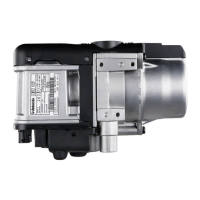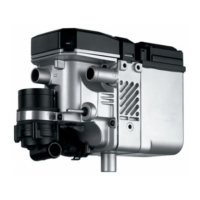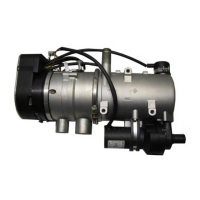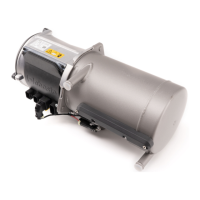Do you have a question about the Webasto DBW 46 and is the answer not in the manual?
Steps for handling malfunctions, including checking fuses and electrical connections, and restarting the heater.
Details on German certification, installation requirements, and keeping approval certificates.
Requirement for marking the year of initial operation and conditions for asserting claims.
Warnings against operating in enclosed spaces, at filling stations, or near combustible materials.
Mandatory annual inspection and immediate action for severe smoke or unusual noises.
Using specified fuel and avoiding exposure to temperatures above 85°C to prevent damage.
Checking cooling water, antifreeze, and Webasto's liability regarding installation and repairs.
Overview of timer capabilities, including preset times and fast time-setting mode.
Manual and automatic switching on/off of the heater using the timer.
Procedure for setting the current time and day of the week on the timer.
Setting specific start times for the heater in different memory locations.
How to view, select, and delete previously programmed heater start times.
Setting the desired duration for the heater's operation.
Adjusting the heater's remaining operation time while it is running.
Overview of the Telestart T60 system for remote heater control and its range.
Procedure for switching the heater on remotely using the transmitter.
Manual and automatic methods for switching the heater off remotely.
Instructions for inserting and checking batteries in the Telestart transmitter.
Solutions for common issues like the transmitter indicator not flashing or receiver not switching on.
Steps for handling malfunctions, including checking fuses and electrical connections, and restarting the heater.
Details on German certification, installation requirements, and keeping approval certificates.
Requirement for marking the year of initial operation and conditions for asserting claims.
Warnings against operating in enclosed spaces, at filling stations, or near combustible materials.
Mandatory annual inspection and immediate action for severe smoke or unusual noises.
Using specified fuel and avoiding exposure to temperatures above 85°C to prevent damage.
Checking cooling water, antifreeze, and Webasto's liability regarding installation and repairs.
Overview of timer capabilities, including preset times and fast time-setting mode.
Manual and automatic switching on/off of the heater using the timer.
Procedure for setting the current time and day of the week on the timer.
Setting specific start times for the heater in different memory locations.
How to view, select, and delete previously programmed heater start times.
Setting the desired duration for the heater's operation.
Adjusting the heater's remaining operation time while it is running.
Overview of the Telestart T60 system for remote heater control and its range.
Procedure for switching the heater on remotely using the transmitter.
Manual and automatic methods for switching the heater off remotely.
Instructions for inserting and checking batteries in the Telestart transmitter.
Solutions for common issues like the transmitter indicator not flashing or receiver not switching on.
| Fuel Type | Diesel |
|---|---|
| Weight | 4.5 kg |
| Power Supply Voltage | 12 V / 24 V |
| Voltage | 12 V |
| Operating Pressure | 1.5 bar |
| Protection Class | IP X4 |












